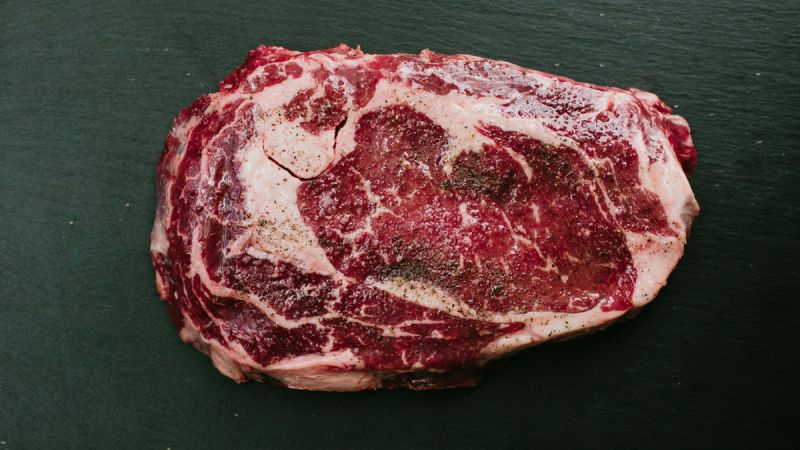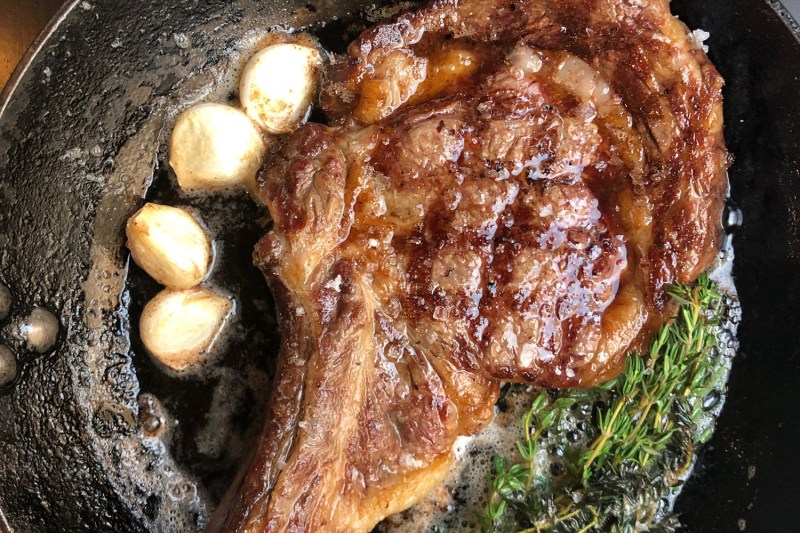If you love a good steak, chances are you have a favorite cut. For those who like things a little lighter, a good filet is always lovely. The versatility of cuts like flank and skirt steak are the resourceful cook’s dream. If it’s a warm and cuddly, stick-to-your-ribs kind of meal you’re in the mood for, beautifully braised short ribs are always a comfort. The list goes on, and, yes, can be a bit daunting. The world of meat cuts is a complex one, and you aren’t alone if you’ve stood in front of the butcher counter, befuddled and overwhelmed. So we’ll make it simple for you. If it’s a lusciously meaty, gorgeously marbled, rich and tender, melt-in-your-mouth, fill-you-with-love-for-your-fellow-man kind of steak you want, go with the ribeye.
From the same section of the cow as the prime rib, a ribeye is a single steak, sliced on its own, taken from the rib section of the cow. Whereas a prime rib is the entire beef rib primal cut, meant to be roasted whole and served to many. Basically, if you were to take an entire prime rib and slice between the bones, you would be left with roughly six to eight ribeyes. However, the ways these two cuts of meat are prepared are hugely different. While a prime rib is best when slow-roasted, a single ribeye is best cooked quickly on high heat, providing a delicious sear and sinfully juicy center. There are many ways to accomplish this, but our favorite is with a good ol’ fashioned cast iron skillet like grandma used to have.

The beauty in the ribeye comes from its marbling (which is just a fancy word for fat). Unlike many other cuts of beef, the veins of fat running through a ribeye are what gives it so much wonderful flavor and texture. When that fat hits a scorching hot pan, something magical happens. Technically, this is called the Maillard Reaction — the browning that occurs when fat meets heat. And the beautiful fat, marbled throughout the ribeye, causes a damned gorgeous browning miracle.
So how do you make one of these beauties at home? Sure, the ribeye is often the most popular menu item at any fancy steakhouse. And for good reason. But making your own is quick and simple — no fancy culinary degree is required. Even the ingredient list is tiny. With a great piece of meat, some salt and pepper, a bit of garlic, and a few herbs thrown in the pan, you’ve got yourself a dish that will impress even the most difficult to please. Except for vegetarians. For those guests, you’ll need to make a meatless alternative, with our sympathies.
Ribeye Recipe

Ingredients:
- 1 2-inch-thick, boneless ribeye steak
- 3 tablespoons canola oil
- 2-3 garlic cloves, smashed
- 2-3 sprigs fresh thyme
- 2-3 sprigs fresh rosemary
- 4 tablespoons butter
- Kosher salt
- Freshly ground black pepper
Method:
- Season ribeye generously with salt and pepper and allow to rest on the counter for up to 30 minutes
- Heat the cast iron skillet on high, then add canola oil and allow it to heat in the pan until it shimmers
- Carefully (the hot oil will pop) add the ribeye to the pan and allow to sear for about 2-3 minutes
- Flip the ribeye and cook another minute on medium-high heat
- Add garlic, thyme, rosemary, and butter to the pan and reduce heat to medium
- Using a spoon, baste the ribeye with the melted butter for the duration of cooking, another 3-5 minutes
- Remove ribeye from the pan and allow to rest for 10 minutes before cutting into it (we know this waiting period is torture, but trust us)
- While the ribeye is resting, pour all of the buttery, garlicky goodness leftovers in the pan directly on top of your steak and let it sink in
Tips and Tricks for Cooking Ribeyes
- Be sure to only smash your garlic cloves. Because of the high cooking temperature, minced garlic will likely burn and create a very bitter flavor. Not sexy.
- Both resting periods in this recipe are important. Before cooking, it’s crucial that your steak be brought to room temperature to ensure even cooking. After cooking, the steak needs time to retain all of its delicious juices. If cut too quickly, you’ll lose many of the juices that help make the ribeye so wonderful.
- This recipe calls for canola oil because of its ability to take the heat. Olive oil will burn at this high temperature, so an oil with a high smoke point like canola is best here.
- Yes, it’s a lot of butter. We never said this was a healthy recipe. Just embrace it.
- This recipe will give you a medium-rare ribeye, which, in our opinion, is the best way to eat one. But if you prefer your steak at a different temperature, cook a little longer and use a well-calibrated meat thermometer to determine your preferred doneness.
- Rare: 125 F
- Medium rare: 135 F
- Medium: 145 F
- Medium well: 155 F (please don’t do this)
- Well done: 165 F (how dare you)
In our opinion, there’s just never a bad time for a ribeye. Whether you’ve got guests to impress, or a solo Tuesday night to watch Netflix, this steak is always a good choice. While it’s filling and lovely on its own, classic accompaniments like mashed potatoes and roasted vegetables are welcome pairings. You really can’t go wrong. Unless you like it well done, you barbarian.
Editors' Recommendations
- Tips and tricks: A pro chef reveals how to cook prime rib
- Hamburger expert George Motz walks us through how to cook the perfect hamburger
- A novice cheesemaker’s guide on how to make cheese at home
- This delicious quiche recipe is fit for royalty (literally) and perfect for brunch
- Exclusive: this easy dill pickle pimento cheese dip recipe is perfect for spring snacking




